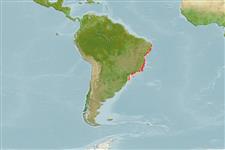Environment: milieu / climate zone / depth range / distribution range
पारिस्थितिकी
समुद्री प्रवाल-भित्ति संयुक्त; गैर प्रवासी; गहराई सीमा 0 - 30 m (Ref. 7247). Tropical; 6°S - 30°S, 50°W - 31°W
Western Atlantic: Brazil. Caribbean (described from Cuban specimens) species refers to Stegastes xanthurus (formerly considered as a junior synonym of S. variabilis). Populations from Brazil and the Caribbean are genetically very distinct (Roberstson & van Tassell, 2012; accessed 08 August 2016; http://biogeodb.stri.si.edu/caribbean/en/thefishes/species/3884).
आकार / वज़न / Age
Maturity: Lm ? range ? - ? cm
Max length : 12.5 cm TL पुल्लिंग / अलिंग; (Ref. 9626)
पृष्ठीय रीढ़ (सम्पूर्ण) : 12; पृष्ठीय सौफट रेज़ (सम्पूर्ण) : 14 - 17; गुदा कांटा: 2; ऐनल सौफट रेज़: 12 - 15. Caudal fin slightly forked, with rounded lobes. Dark brown or blue above, shading to yellow below. Narrow, dark, obliquely vertical lines on side. Snout and forehead have bright blue lines. Small dark spot in pectoral axil, another on top of caudal peduncle (Ref. 26938).
Adults inhabit inshore and offshore coral reefs. They feed mainly on benthic algae but also on sponges, ascidians and anemones while juveniles feed on invertebrates like harpacticoid copepods and nemerteans (Ref. 9626). Often solitary (Ref. 9626). Juveniles are aggressively territorial (Ref. 9626). Aggressive when breeding (Ref. 9710). Oviparous, distinct pairing during breeding (Ref. 205). Eggs are demersal and adhere to the substrate (Ref. 205). Males guard and aerate the eggs (Ref. 205). Taken incidentally in traps and small-meshed beach nets (Ref. 5217).
Life cycle and mating behavior
Maturities | पुनरुत्पत्ति | Spawnings | Egg(s) | Fecundities | लार्वा
Oviparous, distinct pairing during breeding (Ref. 205). Eggs are demersal and adhere to the substrate (Ref. 205). Males guard and aerate the eggs (Ref. 205).
Allen, G.R., 1991. Damselfishes of the world. Mergus Publishers, Melle, Germany. 271 p. (Ref. 7247)
IUCN Red List Status (Ref. 130435)
Threat to humans
Harmless
Human uses
मात्स्यिकी: व्यापारिक; जलजीवालय: व्यापारिक
साधन
Special reports
Download XML
इंटरनेट स्रोत
Estimates based on models
Preferred temperature (Ref.
123201): 22.5 - 27.5, mean 25.9 °C (based on 139 cells).
Phylogenetic diversity index (Ref.
82804): PD
50 = 0.5000 [Uniqueness, from 0.5 = low to 2.0 = high].
Bayesian length-weight: a=0.01622 (0.00923 - 0.02851), b=2.99 (2.84 - 3.14), in cm total length, based on LWR estimates for this species & Genus-body shape (Ref.
93245).
लौटाव (Ref.
120179): ऊंचा, न्यूनतम जनसंख्या दुगनी समय अवलागत 15 महीने। (Preliminary K or Fecundity.).
Fishing Vulnerability (Ref.
59153): Low vulnerability (10 of 100).
Nutrients (Ref.
124155): Calcium = 103 [52, 161] mg/100g; Iron = 0.741 [0.459, 1.216] mg/100g; Protein = 18.1 [17.0, 19.3] %; Omega3 = 0.11 [0.07, 0.18] g/100g; Selenium = 25.1 [13.9, 46.7] μg/100g; VitaminA = 81.5 [21.8, 278.2] μg/100g; Zinc = 1.75 [1.19, 2.54] mg/100g (wet weight);
